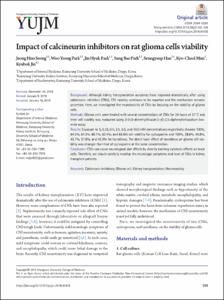KUMEL Repository
1. Journal Papers (연구논문)
1. School of Medicine (의과대학)
Dept. of Internal Medicine (내과학)
Impact of calcineurin inhibitors on rat glioma cells viability
- Keimyung Author(s)
- Park, Woo Young; Paek, Jin Hyuk; Park, Sung Bae; Han, Seung Yeup; Mun, Kyo Cheol; Jin, Kyu Bok
- Journal Title
- Yeungnam University Journal of Medicine
- Issued Date
- 2019
- Volume
- 36
- Issue
- 2
- Abstract
- Background:
Although kidney transplantation outcomes have improved dramatically after using calcineurin inhibitors (CNIs), CNI toxicity continues to be reported and the mechanism remains uncertain. Here, we investigated the neurotoxicity of CNIs by focusing on the viability of glioma cells.
Methods:
Glioma cells were treated with several concentrations of CNIs for 24 hours at 37°C and their cell viability was evaluated using 3-(4,5-dimethylthiazol-2-yl)-2,5-diphenyltetrazolium bromide assay.
Results:
Exposure to 0, 0.25, 0.5, 2.5, 5.0, and 10.0 mM concentrations respectively showed 100%, 64.3%, 61.3%, 68.1%, 62.4%, and 68.6% cell viability for cyclosporine and 100%, 38.6%, 40.8%, 43.7%, 37.8%, and 43.0% for tacrolimus. The direct toxic effect of tacrolimus on glioma cell viability was stronger than that of cyclosporine at the same concentration.
Conclusion:
CNIs can cause neurological side effects by directly exerting cytotoxic effects on brain cells. Therefore, we should carefully monitor the neurologic symptoms and level of CNIs in kidney transplant patients.
- Publisher
- School of Medicine (의과대학)
- Citation
- Jeong Hun Seong et al. (2019). Impact of calcineurin inhibitors on rat glioma cells viability. Yeungnam University Journal of Medicine, 36(2), 105–108. doi: 10.12701/yujm.2019.00108
- Type
- Article
- ISSN
- 2384-0293
- Source
- https://yujm.yu.ac.kr/journal/view.php?number=2420
- Appears in Collections:
- 1. School of Medicine (의과대학) > Dept. of Biochemistry (생화학)
1. School of Medicine (의과대학) > Dept. of Internal Medicine (내과학)
- 파일 목록
-
-
Download
 oak-2019-0256.pdf
기타 데이터 / 663.39 kB / Adobe PDF
oak-2019-0256.pdf
기타 데이터 / 663.39 kB / Adobe PDF
-
Items in Repository are protected by copyright, with all rights reserved, unless otherwise indicated.